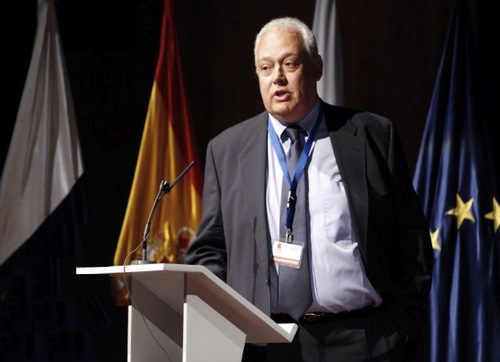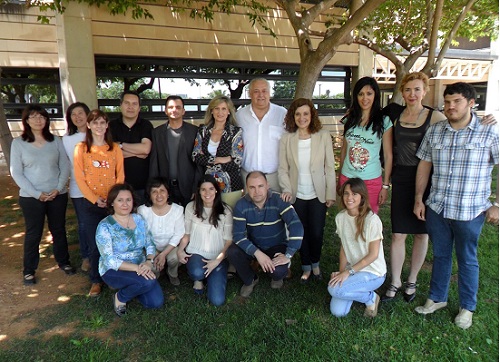.jpg)
Interview with Dr Ricardo Pérez Sánchez, graduate of Pharmacy from the University of Salamanca and member of the Institute of Natural Resources and Agrobiology of Salamanca (IRNASA), which is part of the Spanish National Research Council (CSIC).
16 october 2014
BIOGRAPHICAL PROFILE:
- Name: Ricardo Pérez Sánchez
- Member of: Institute of Natural Resources and Agrobiology of Salamanca (IRNASA) of the Spanish National Research Council (CSIC)
- Email: perez@irnasa.csic.es
After graduating in Pharmacy from the University of Salamanca (1987), I pursued my doctoral thesis in the Parasitology Department of the same university (1990).
I completed my postdoctoral training (1991–1992) at the Severo Ochoa Molecular Biology Centre (CSIC – Autonomous University of Madrid), in Dr Eladio Viñuela’s laboratory.
I then joined the teaching staff of the University of Salamanca – first, as a teaching assistant, and later, as an adjunct professor until 2000.
At that moment, I started to work at IRNASA (CSIC), where I am currently a scientific researcher.
INTERVIEW
- What are your lines of research and what is your current objective? Who is participating in this research?
My activity is part of IRNASA’s line of research “Parasitosis of livestock farming and parasitic zoonosis”. The aim is to analyse livestock parasites at a molecular level and transfer the new technologies developed for preventing, vaccinating and diagnosing parasitic diseases to the production sector.
Within this area, my main research activity has focused on hematophagous arthropods, particularly ticks, as they are vectors of many pathogenic microorganisms, both in humans and animals. We study the Argasidae (soft ticks) Ornithodoros erraticus and Ornithodoros moubata because of their function as vectors of African swine fever virus (ASFV) and the Spirochaetota bacteria of Borrelia genus, which cause human relapsing fever.
Our goal is to identify and characterise these ticks’ saliva molecules, as they regulate the relationship between the tick and the host. One of the functions of the saliva molecules is to neutralise the hemostatic, inflammatory and immune defence responses of the host, which allows the tick to ingest the blood and, at the same time, facilitates the pathogen’s invasion of the host. These molecules are of particular interest in the development of new vasoactive, anti-inflammatory and immunomodulating pharmaceuticals, serological tests to evaluate the risk of exposure to hematophagous vectors and anti-tick vaccines that block their nutrition and the transmission of pathogens.
Currently, five people from IRNASA are working on this line of research, including a predoctoral fellow and two technicians.
- What have been the main advances or discoveries in the field of parasitology in recent years?
Without any doubt, the application of systems biology to parasites while integrating functional genomics, transcriptomics and proteomics data. This allows the annotation of an increasing number of parasitic genomes.
- What have been the biggest discoveries of your scientific career?
As they are the most tangible, I would highlight those with a practical application currently in use, such as the serological tests for diagnosis of parasitisms by Ornithodoros. These tests were successfully applied in Spain in the 90s, contributing to eradicate the African swine fever (ASF) from our country. Right now, they are being used in several Eastern European countries that were recently affected by ASF, as well as in endemic zones of this disease in Eastern and Southern Africa. I would also include the obtention of different recombinant antigens for the development of anti-Ornithodoros vaccines as a method of control of these vectors’ populations and prevention of the diseases they transmit.
- How did you discover your scientific calling?
I was amazed by the “ingenuity” of parasites and how they live at the expense of their host, something that still continues to impress me as I get to know them even better. For this reason, during my 5th year of Pharmacy studies, I talked to Dr Antonio Encinas, who introduced me to the fascinating world of hematophagous arthropods.
- What do you think about how scientific careers are structured in Spain?
On paper, it seems reasonable, at least during the pre and postdoctoral periods. The problem arises later, when integrating young researchers into our national research system. Research opportunities in private institutions and enterprises are limited, and Public Research Organisations (OPI) cannot take in everyone. Currently, returning to Spain implies, in the best of the cases, a series of temporary contracts with no guarantee of stability, which can discourage even the most enthusiastic people.
- What is your advice for young researchers that are starting their scientific career or to those already in the parasitology field?
If they truly like what they do, I would advise them not to be discouraged and to persevere. There are always opportunities, although I fear that, nowadays, they will have to look for them outside Spain.
- What scientific challenges are you currently facing, on both the national and international level?
Identifying target antigens that can induce 100% efficient protective anti-tick responses. But at the same time, I am content with providing solid knowledge on candidate antigens that will allow us to advance towards this goal.


.jpg)










